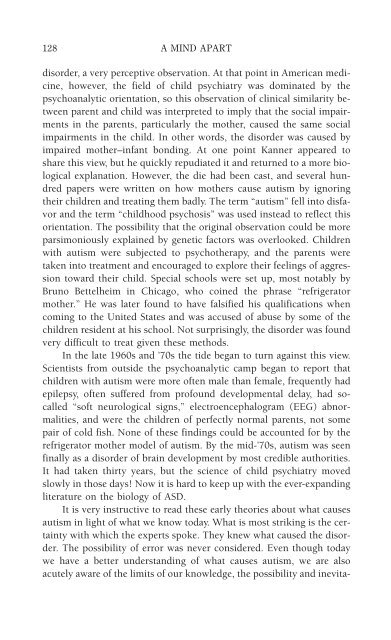978-1572305441
autism
autism
You also want an ePaper? Increase the reach of your titles
YUMPU automatically turns print PDFs into web optimized ePapers that Google loves.
128 A MIND APART<br />
disorder, a very perceptive observation. At that point in American medicine,<br />
however, the field of child psychiatry was dominated by the<br />
psychoanalytic orientation, so this observation of clinical similarity between<br />
parent and child was interpreted to imply that the social impairments<br />
in the parents, particularly the mother, caused the same social<br />
impairments in the child. In other words, the disorder was caused by<br />
impaired mother–infant bonding. At one point Kanner appeared to<br />
share this view, but he quickly repudiated it and returned to a more biological<br />
explanation. However, the die had been cast, and several hundred<br />
papers were written on how mothers cause autism by ignoring<br />
their children and treating them badly. The term “autism” fell into disfavor<br />
and the term “childhood psychosis” was used instead to reflect this<br />
orientation. The possibility that the original observation could be more<br />
parsimoniously explained by genetic factors was overlooked. Children<br />
with autism were subjected to psychotherapy, and the parents were<br />
taken into treatment and encouraged to explore their feelings of aggression<br />
toward their child. Special schools were set up, most notably by<br />
Bruno Bettelheim in Chicago, who coined the phrase “refrigerator<br />
mother.” He was later found to have falsified his qualifications when<br />
coming to the United States and was accused of abuse by some of the<br />
children resident at his school. Not surprisingly, the disorder was found<br />
very difficult to treat given these methods.<br />
In the late 1960s and ’70s the tide began to turn against this view.<br />
Scientists from outside the psychoanalytic camp began to report that<br />
children with autism were more often male than female, frequently had<br />
epilepsy, often suffered from profound developmental delay, had socalled<br />
“soft neurological signs,” electroencephalogram (EEG) abnormalities,<br />
and were the children of perfectly normal parents, not some<br />
pair of cold fish. None of these findings could be accounted for by the<br />
refrigerator mother model of autism. By the mid-’70s, autism was seen<br />
finally as a disorder of brain development by most credible authorities.<br />
It had taken thirty years, but the science of child psychiatry moved<br />
slowly in those days! Now it is hard to keep up with the ever-expanding<br />
literature on the biology of ASD.<br />
It is very instructive to read these early theories about what causes<br />
autism in light of what we know today. What is most striking is the certainty<br />
with which the experts spoke. They knew what caused the disorder.<br />
The possibility of error was never considered. Even though today<br />
we have a better understanding of what causes autism, we are also<br />
acutely aware of the limits of our knowledge, the possibility and inevita-



